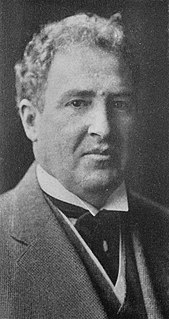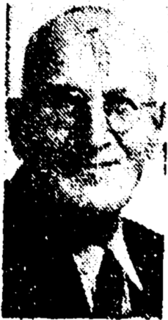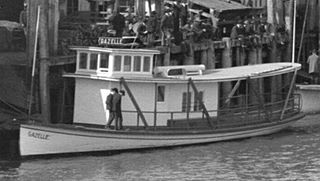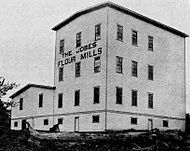
The Spokane, Portland & Seattle Railway (SP&S) was a railroad in the northwest United States. Incorporated in 1905, it was a joint venture by the Great Northern Railway and the Northern Pacific Railway to build a railroad along the north bank of the Columbia River. Remnants of the line are currently operated by BNSF Railway and the Portland and Western Railroad.

St. Johns is a neighborhood of Portland, Oregon, United States, located in North Portland on the tip of the peninsula formed by the confluence of the Willamette River and the Columbia River. It was a separate, incorporated city from 1902 until 1915, when citizens of both St. Johns and Portland voted to approve its annexation to Portland, which took effect on July 8, 1915.

Linnton is a Portland, Oregon neighborhood located between Forest Park and the Willamette River along U.S. Route 30, close to the agricultural community of Sauvie Island. It borders the neighborhoods of Northwest Industrial on the south, St. Johns and Cathedral Park via the St. Johns Bridge across the Willamette on the east, and Forest Park on the west. The neighborhood extends north somewhat beyond Portland city limits into unincorporated Multnomah County, ending at the Sauvie Island Bridge.

The Oregon Railroad and Navigation Company (OR&N) was a railroad that operated a rail network of 1,143 miles (1,839 km) of track running east from Portland, Oregon, United States to northeastern Oregon, northeastern Washington, and northern Idaho. The railroad operated from 1896 as a consolidation of several smaller railroads.

Jacob Kamm was a prominent early transportation businessman in Oregon, USA.

John Virginius Bennes was an American architect who designed numerous buildings throughout the state of Oregon, particularly in Baker City and Portland. In Baker City he did an extensive redesign of the Geiser Grand Hotel, designed several homes, and a now-demolished Elks building. He moved to Portland in 1907 and continued practicing there until 1942.

Morris Homans Whitehouse was an American architect whose work included the design of the Gus Solomon United States Courthouse in Portland, Oregon.
Harry Taylor Bagley was an American attorney and politician in the state of Oregon. A native of Ohio, he was raised in Washington County, Oregon, where he practiced law and was a local official. He also served as a two-term mayor of Hillsboro, the county seat, and under his administration the city's public works were modernized and roads paved for the first time.

Francis I. McKenna was a real estate and land developer, and architect from the 1890s to the 1920s in Portland, Oregon. McKenna moved to Portland in 1889 and purchased the land now known as the University Park neighborhood. He went on to establish the Portland Belt Line Company, which lobbied city officials to extend the cable car system to St. Johns, Oregon. The project was constructed in 1905. McKenna was also known as an advocate of civic improvement and industrialization.

The Portland Woolen Mills were a wool textile manufacturer in the St. Johns neighborhood of Portland, Oregon. By 1950, they had become the largest wool manufacturer west of Cleveland, Ohio. The origins of the factory started in Sellwood in 1901 but after a fire destroyed the mill two years later owners decided to rebuild in St. Johns. Portland Woolen Mills offered several worker programs including baseball, basketball and bowling teams; a cafeteria and a library.

James John (1809–1886) was founder of the settlement of St. Johns in Oregon. The area later became a city when it passed a charter in 1902. It was annexed into Portland in 1915. John worked as a general store and ferry operator across the Willamette River to Linnton. He once served as Justice of the Peace and was twice an election judge. John was born in Ohio and first settled in Indiana with his wife and child where John worked as an educator. He joined the Bartleson–Bidwell Party in 1841, who were one of the first groups that trekked the California Trail. By this time, John's wife and child had died. He came to Oregon Country in the employment of the Hudson's Bay Company in 1843 after making it to Sacramento Valley.

George R. Vosburg was a steam tug that operated from 1900 to 1912 on the Columbia River and the north coast of Oregon south from Astoria to the Nehalem River and Tillamook City. Generally called the Vosburg in practice, and referred to as Geo. R. Vosburg in official records, this vessel performed many tasks, from carrying cargo and passengers, and towing barges of rock for jetty construction. After 1925, this vessel was renamed George M. Brown, and was converted to diesel power. Under the name George M. Brown, this vessel remained in service until 1968 or later.

Klamath was the first and only vessel larger than a launch to operate on Lower Klamath Lake, which straddled the border between the U.S. states of Oregon and California. This vessel is chiefly known for having been hauled overland by rail from Lake Ewauna to Upper Klamath Lake. It was also one of only two licensed merchant vessels ever to operate on lower Klamath Lake. During 1905 to 1909, Klamath was an essential link in a transportation line to Klamath Falls which involved rail, stage coach, and steamer travel. The late arrival of railroads to the Klamath lakes region made riverine and lake transport more important to the area.

Geibisch and Joplin was a contracting and paving company in Portland, Oregon in the 1900s and 1910s. The company was run by Ada Joplin and her husband Anton Geibisch, married on 8 June 1892. The company built the original Brooklyn neighborhood sewers in Portland, Oregon, as well as jetties in Coos Bay and Clatsop, Oregon although they primarily laid sidewalks and streets. Geibisch and Joplin also started a condensed milk plant in Bandon, Oregon.

Telephone was a sternwheel-driven steamboat built in 1884 by Captain Uriah Bonsor “U.B.” Scott for service on the Columbia River. Reputedly the fastest steamboat in the world in its time, Telephone served on the Columbia River and San Francisco Bay. Telephone was rebuilt at least twice. The first time was after a fire in 1887 which nearly destroyed the vessel. The reconstructed and much larger second vessel was sometimes referred to as Telephone No. 2. The third vessel, Telephone No. 3, built in 1903 and using components from the second steamer was larger but little used during its time on the Columbia river.

Gazelle was a gasoline powered launch that operated on the Willamette and Columbia river from 1905 to 1911. For short periods of time Gazelle was operated on the Oregon Coast, on Yaquina Bay and also as an off-shore fishing vessel, in the Coos Bay area.

Mascot was a sternwheel-driven steamboat built in 1890 which operated primarily on a route running from Portland, Oregon down the Willamette and Columbia rivers to points on the Lewis and Lake rivers. Points served included the town of Woodland, Washington, on the main branch of the Lewis, and La Center, Washington on the east fork.

Etna was a steamboat that operated on the Lewis and Lake rivers of southwestern Washington from 1906 to 1919. As built in 1906 Etna was originally powered by a gasoline engine, but in 1907 it was converted to steam-powered vessel.

George Harris Merryman was a country doctor, businessman, and politician from the U.S. state of Oregon. A Republican, he served two non-consecutive terms in the Oregon House of Representatives. In between those terms, he was elected to the Oregon State Senate for one term. In both the house and senate, the districts he represented were large and rural. Merryman was also a pioneer doctor who made house calls by horse and buggy for many years. He later built the first modern hospital in Klamath Falls, Oregon.

William Herman "Bill" Rapps was a professional baseball player whose career spanned 15 consecutive seasons—1903 to 1917—in Minor League Baseball. He was known by several nicknames over his career, the most frequent being "Roaring Bill" for his boisterous on-field performance. Over his career, he played a number of positions, the most frequent being outfield and first base. In 1907, he was moved to second base and in 1914 became a backup catcher.



















